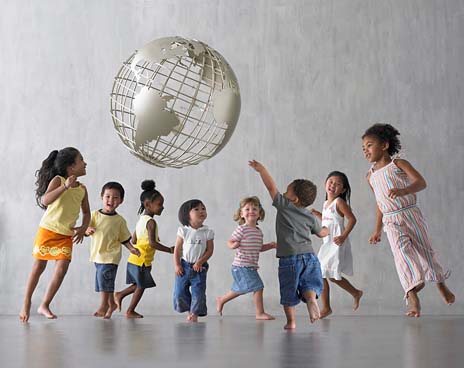 Children are not, by nature, racist. Nor are they born with damaging assumptions about people in any definable group.
Children are not, by nature, racist. Nor are they born with damaging assumptions about people in any definable group.
We all begin with a winning trust in others, an expectation that people will be good to each other, and that life with others will be safe and fun. When a child feels close to his parents, gets to play freely with lots of laughter, gets plenty of affection, and has sensible limits set by grown-ups who don't attack him, a young person can feel at home with himself, and relaxed with others.
Contrary to popular belief, children have a keen inborn sense of justice. They are built to protest loudly when they or someone else is being treated badly. This sense of justice runs deep. You probably can remember times in your childhood when you or someone you cared about was attacked, verbally or physically. You didn't have to be told that this treatment was wrong and should be stopped immediately. You just knew.
We don't have to teach children respect for people of other races and abilities. We simply need to preserve their trust in themselves and others, and their inborn sense of justice. If a child feel safe and strong, he will respond with indignation to racism, whether it's directed at him or at someone else. He will know that the racist attitude he has witnessed is wrong, and won't adopt it as his own.
Treating children with respect
Children are able to retain their keen sense of justice if they are treated with respect. Respectful treatment that inoculates a child against racism means several very specific things.
- The child is appreciated for who he is, regardless of what he can or can't do.
- The child is not typecast. Generalizations like “shy,” “loud,” “bossy,” are not used, and put-downs like “bratty,” “whiny,” and “stupid” are also off-limits.
- The child's curiosity is supported. When questions are asked about why people look or act the way they do, those questions are warmly answered at a level the child can understand. In other words, it's OK to be interested in all aspects of being human.
- The child is not compared to others, and judgments like “bad,” “good,” “better,” and “best” aren't used to classify him or other people. This means, for instance, that when asked why some people are sent to jail, a parent would explain that those people have done something seriously hurtful to someone else, not that those are bad people. Or, a parent would ask a child who is kicking others under the dinner table to wrap his legs around the chair legs rather than telling him he's a bad boy.
- The child is not intimidated for having upsets about the things that matter to him. In particular, the child is allowed to express feelings with crying, tantrums, and “freedom of the mouth” while crying or tantruming. You, as parent, will often set limits that upset your child. That's your job, and it's an important one. However, your child's job is then to blast away the bad feelings that those limits bring forth, so he can recover his sense that you care and that his life is a good one. When a child cries, has a tantrum, or storms in response to a limit, he is using an inborn healing and cleansing process. He needs your attention while he gets rid of awful feelings. It restores your child's sense that his life is good, and his trust in you and others.
- The child is not hit, slapped, threatened with physical attack, shamed, or blamed. These kinds of attacks by adults leave big emotional scars on children, and impress them with the notion that some people deserve to be called “bad” and then mistreated.
In short, what makes children vulnerable to racism is to treat children like we are better than they are, we know better than they do, we are more important than they are, and our feelings have more validity than their feelings. Instead, we need to guide them with respect for their intelligence, whether they are acting intelligently at the moment or not.
Racism “piggybacks” on early mistreatment and fears
Racist attitudes and stereotypes, and, for children of color, the internalizing of racist attitudes, are what we call “piggyback hurts.” The mechanism of racism works like this:
- A child has bad experiences, either at the hands of adults or during threatening accidents or illnesses. He carries feelings of being terrified, separate, helpless, and unable to fight for himself. These feelings can be kicked into play by small incidents like not getting the first turn at bat, or losing his lunch pail, or having heard a fight between his parents. His fears make him withdraw at times, and at other times, those fears make him aggressive and angry.
- When any child witnesses racism, it frightens him. The racism fastens onto fears that have cracked a child's confidence in himself and others, like a secondary infection invades an open wound. He doesn't feel good enough or strong enough to reject racist mistreatment and protest it. So the words, tones, and attitudes are imprinted in his mind, along with a fresh helping of fear.
- If he is a child of color, his fears have propped the door open for the racist tones, words, and stereotypes to enter his mind and become part of how he thinks about himself and his people. When he feels upset, separate, afraid, or angry, he will believe the racist content. A child of color who is feeling upset may also act out the oppressor role of racism, targeting either himself or other children of color.
- A white child's fears also make him vulnerable to adopting racist tones, words, and stereotypes. When a white child feels separate, scared, or disconnected, he tries to escape these feelings by playing out the oppressor role he has been frightened by. The intensity of his actions will reflect the depth of the fears that the child carried before the racism he witnessed gave those fears a racial twist.
Listen to the feelings to heal the child
The key activity parents can adopt is to listen to children's feelings so that they can heal from their fears and upsets, no matter what the content of these upsets.
- When a child has been hurt in an interaction with another child, whether racist content was part of the incident or not, both children need to talk about what happened, and supported to cry, tantrum, or rage. Support the child's inborn sense that you care and people can be trusted to be good at heart with messages like: “You can talk to her about this.” “What do you want to say to her?” “How did that feel to you?” “I'm so sorry you two had trouble—you're both so fine.” “Let's finish getting mad right now, so you don't have to always be mad at her.” “I'll help you talk to her in a little while, when you're ready.”
- Don't assume that because a racial epithet was used, or because the children who collided are of different races, that this is a racial incident. It's much better for children if we deal with them as individuals, not as members of a racial group. Children don't relate to the concept of racial identity until they are eight to ten years old. Even then, the antidote to racism is seeing and caring about the person.
- Role play so that your child gets to play-act at having the upper hand with the child he felt hurt by. Pillow fights are great for helping your child playfully take a powerful role in sticking up for himself. Don't worry about “bad” words and epithets when you're giving him this time to vent. See what you can do to promote laughter. Laughter while in the more powerful role releases children's fears and helps them regain their sense of connection to you. They need to know you care about them before they can have faith in anyone else in their world.
Protect children from exposure to racism
The two most powerful purveyors of racism in our children's lives are the media and the adults they know. Since racism frightens children, the older they are before they encounter it, the more able they are to understand that only people who have been badly treated would act like that.
Fairy tales, TV, videos, and video games all are full of messages of fear, and fear lays fertile ground for the “isms.” It makes sense to strictly limit children's exposure to infection from these sources. This will make your family different from other families: being different is great practice for standing up, kindly and firmly, for ourselves and what we believe.
Parents of color can work to interrupt internalized racism, the use of racial put-downs by people of color toward other people of color. This means standing up to family members who say, “Aw, you know I don't mean anything by it,” and, “Hey, he's going to hear this anyway. Might as well hear it from me!” We also have to keep working through the hatred of ourselves that is usually the root cause of those put-downs. Children are not “toughened up” by racism coming from their folks. They are hurt and confused by it. Fear and anger grow between them and the loved ones who treat them this way, however well-intentioned those loved ones are.
It helps children when we explain to them that people act thoughtlessly because, once upon a time, they were themselves harshly treated, and they haven't had the chance to heal. A policy of dealing with difficult incidents, detail by detail, with faith that the people involved can certainly work out their upsets and come to understand each other is one which can disarm stereotyping. We need to work on our own feelings of worry and fear to stay hopeful for our children, and active in taking initiative to help people see each other as friends and allies.
White parents can acknowledge their own fears and talk about them openly and regularly with a good listener. We have been raised to feel so separate, so wary, and often, so superior. The way out is to notice our own behavior, find a listener (not a person of color), and try to notice the feelings behind the tightness. We also need to know that our fears need not stop us from making friends with people of color even when it means making mistakes as we go.
Friendship—relaxed, unguarded human contact—is at the heart of undoing racism and every other “ism”
The most powerful model we can provide is to reach out and get to know people who are different from us. White people can encourage each other and be listeners for each other in these efforts. People of color can support each other, too, and listen to the pain and memories of bad experiences that will inevitably arise as steps toward friendship are bravely taken.
